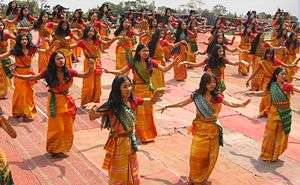Bagurumba
 Bodo girls dancing the Bagurumba dance | |
| Genre | Folk |
|---|---|
| Origin | Assam and Northeast India |
Bagurumba' (Bodo: बागुरुम्बा) is a folk dance of indigenous Bodo tribe in Assam and Northeast India. It is a traditional dance which is traditionally inherent to one generation to another generations. The Bodo women perform the Bagurumba dance with their colourful dokhna, jwmgra (fasra) and aronai. The Bagurumba dance is accepted as main traditional dance of Bodo people. But there are some other important dances like- Bardwisikhla dance, Mwsaglangnai dance, Dahal-tungri sibnai dance, Sikri sikla dance, Daosri delai dance, Sa-gwlao mwsanai, Kopri sibnai mwsanai and so on. All these dances are known as Kristi dance. It is also accompanied by musical instruments like kham (a long drum, made of wood and goat skin or other animal’s skin), sifung (flute, made of bamboo), jota (made of iron/tama), serja (a bowed instrument, made of wood and animals skin), and gongwna (made of bamboo), tharkha (a piece of split bamboo).
This Bagurumba dance is originated from nature. Some thousands of years ago it was practiced by the Boro people. Generally Boro people like to stay in a green environment. They love to play with the environment, beauty of nature. So they used to stay in the foothills of the eastern and southern Himalayas, which are generally forest area. There are so many different symbols in this traditional dance, which are imitated from other natural environment. Like – dance of plants, dance of animals, birds, butterfly dance, wave of flowing river, wind etc.
By seeing this bagurumba dance, all Boro people can’t stay calm and quiet. By seeing this dance, suddenly every Bodo people use to dance unknowingly, and they feel peace and happiness in their mind.
There are no certain days and times to perform this dance; this dance can be performed on any occasion, festival and programme. At present Bagurumba dance is famous over the whole world.
“Jath nongabwla
Cool nongabwla
tabwrwm homnanwi-
bamnanwi lagwomwnka
hai lwgw lagwomwnka”
these lines indicate that, if we are not really jath and khul, they might be taken us whenever they want, but we are very much jath and cool so nobody can catch or carry us- it’s a confidential song of Boro women. They thought that, lose character’s women goes to bad practices and if someone comes to catch her, she never protects or restrict them. So we are not that type of women, we are jath and cool.
“Turi barinilai daosen
jwngni lagwalwi dajen”
(kobam gwrwbhwnai) the meaning of this line is- we should not lose / no failure. We must won any games always. It’s a confidential song of boro women.
Musical instruments
Among many different musical instruments, the Bodos use for Bagurumba Dance:
Sifung: This is a long bamboo flute having five holes rather than six as the north Indian Bansuri would have and is also much longer than it, producing a much lower tone.[1]
- Serja: a violin-like instrument. It has a round body and the scroll is bent forward.
- kham : a long drum made of wood and goat skin.
- Jota: made of iron/tama.
- Gongwna: made of bamboo.
See also
References
- ↑ Baruah, S. (1994). "'Ethnic' Conflict as State—Society Struggle: The Poetics and Politics of Assamese Micro-Nationalism". Modern Asian Studies. 28 (3): 649–671. doi:10.1017/S0026749X00011896.
External links
| Wikimedia Commons has media related to Bagurumba. |
- Bodo's Bagurumba at indiantraveldestinations.com